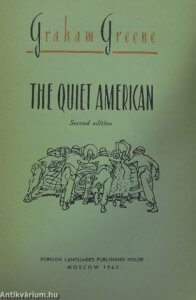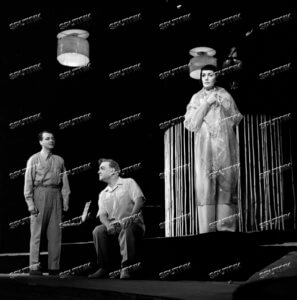The title of Professor Kevin Ruane talk on the Friday morning of the forthcoming festival makes interesting reading: ‘”It was our bible”: US Vietnam War era Reporters (1965-1975) and the impact of Graham Greene’s The Quiet American.’ The Quiet American had been first published in the USA by Viking Press in March 1956. In February 1955, Greene had warned Harold Guinzberg, Viking’s President, that the novel might prove controversial owing to its anti-American sentiments, even suggesting that the publisher should not feel obliged to accept the work. In the event, the book initially received a fairly mixed, critical reception in the States. It took time and the United States’ deepening involvement in South East Asian politics for The Quiet American to have an impact on American sensibilities and for it to gain its reputation as the reporter’s ‘bible’.
In contrast, the Soviet Union was quick to understand and to utilise the propaganda opportunities offered by a central theme in the book: the covert infiltration and exploitation of a third-world country by a capitalist superpower. A stage adaptation of The Quiet American was first performed at the Moscow Drama and Comedy Theatre in 1958. [Andrei Gorzo’s article about Greene’s connections with Romania published on our Current Research page with a slightly  shorter version in the August edition of ASON, refers to this production]. Greene had visited Moscow in 1957 with his son Francis and two years later was evidently keen to make a return visit. In March 1959 he wrote to Tanya Lanina, who worked for the Writer’s Union and also translated some of his books into Russian, suggesting a visit in the autumn of that year. He wrote again to Lanina on 21 May, stating that he had learned from a French newspaper about a Moscow stage adaptation of his Vietnam novel.
shorter version in the August edition of ASON, refers to this production]. Greene had visited Moscow in 1957 with his son Francis and two years later was evidently keen to make a return visit. In March 1959 he wrote to Tanya Lanina, who worked for the Writer’s Union and also translated some of his books into Russian, suggesting a visit in the autumn of that year. He wrote again to Lanina on 21 May, stating that he had learned from a French newspaper about a Moscow stage adaptation of his Vietnam novel.
Lanina’s reply patiently reminded Greene that she had told him about the play already! She had seen a performance and praised it. She found the American Pyle, ‘so very clean and disgusting, innocent and good – and destructive’ while Fowler was, ‘a little bit too talkative’. Greene’s June letter to his translator was full of enthusiasm. He suggested that Lanina might try to persuade the theatre company to cut some of Fowler’s lines. He was going to write to the director to see if he could obtain a copy of the script. He wanted the performance dates in advance of his visit in September. Greene also speculated about the possibility of adapting the Russian version for staging somewhere in Europe.
Greene wrote a week later that he was consulting flight timetables to Moscow and adding that he proposed to bring his friends John and Gillian Sutro. He suggested that the trio might follow their stay in Moscow with an extended visit to Leningrad and maybe ‘Tifilis’ (Tbilisi) or Kiev. Greene proposed to use some of the roubles he had accrued from his Russian royalties to help finance the trip. He also wanted to know if The Quiet American would be in the theatre’s repertory around 7-8 September. On the 11 August, Greene wrote again to Tanya Lanina. Referring to John Sutro’s film and theatrical connections, he hinted that if they liked the play a deal might be struck whereby a translation could be written and a production performed in the UK. However, his letter of the 20 August casts a doubtful note. Greene wrote that other commitments would now prevent him coming to The Soviet Union before ‘sometime in October’.
In the event, Greene did not reach Moscow and see the play until April 1960. A fleeting reference is made in a letter to his daughter which is published in Richard Greene’s Graham Greene: A Life in Letters. He found the play ‘very bad’ and what made things worse was the fact that he had to make a speech from the stage as the performance had been in his honour. Moreover, he was suffering from what turned out to be pneumonia. These matters may or may not have coloured his judgement about the play but subsequently there were no more references made to a translation and production in the West.

Moscow Drama and Comedy Theatre. K. Ignatova as Phuong, A. Polinsky as Fowler, and V. Sokolov as Pyle.
A carbon copy of the typescript of the Russian play version of The Quiet American is to be found in the Greene archives at The University of Tulsa. I am very grateful to Konstantin Shiskin for supplying me with the correspondence which forms the basis of this article. And to Andrei Gorzo for passing on the image of the production (right) which originally drew my attention to the staging of this play in Moscow.
Jon Wise